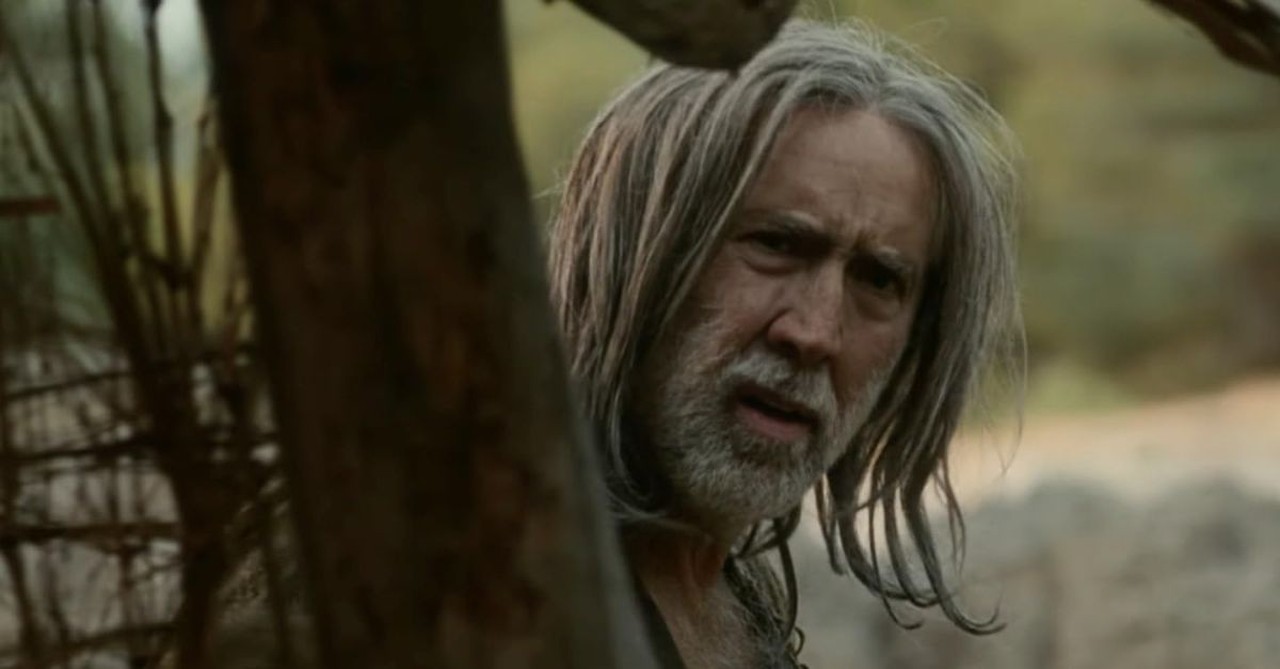3 Ways ‘The Carpenter’s Son’ Strays into Heresy

The Bible doesn’t include much information about the childhood of Jesus.
We know He was born in Bethlehem.
We know His parents fled to Egypt to protect Him from Herod’s murderous decree.
We then read of a story of Jesus at age 12, when He remained in the temple, astonishing the teachers with His understanding.
Despite our curiosity, though, the Bible contains little else to satisfy it.
A new film, though, tries to fill in the blanks – with a horror-filled twist.
The Carpenter’s Son (rated R) suggests that Mary, Joseph, and a teenage Jesus fled to an Egyptian village where they faced resistance from skeptical villagers who believed the teen boy is demonic. To add dramatic tension, the peaceful family we encounter in Scripture is instead portrayed as fractured and full of strife. Nicolas Cage portrays Joseph.
The Carpenter’s Son – sadly – continually strays into heresy. Here are three reasons why:
Photo Credit: ©Magnolia Pictures
It’s Based on a Heretical Document

It’s Based on a Heretical Document
SLIDE 1 OF 3
The film is based on the Infancy Gospel of Thomas, a document dated to the second century that – contrary to its title – was not written by the Apostle Thomas, who was already deceased.
Of course, early Christians accepted the four Gospels (Matthew, Mark, Luke, and John) as God’s Word, knowing they were based on eyewitness testimony and because they were rooted in apostolic authority – either written by the apostles themselves or by close companions. The apocryphal Infancy Gospel of Thomas, by contrast, was rejected by the early church as heretical and fictional.
The historian Eusebius, in his extensive fourth-century book on church history, labeled the document and others like it as “fictions of heretics,” saying they should be “cast aside as absurd and impious.” Likewise, Pope Gelasius – who served as bishop of Rome in the late fifth century – included the Infancy Gospel of Thomas on a list of heretical documents that should be rejected.
Unfortunately, The Carpenter’s Son misleads viewers from the very first frame, when text on the screen suggests that the apocryphal gospels “describe events missing in the timeline of the New Testament” – a claim flatly contradicted by historical evidence.
Photo Credit: ©Magnolia Pictures
It Reduces Jesus to a Flawed, Temperamental Teen

It Reduces Jesus to a Flawed, Temperamental Teen
SLIDE 2 OF 3
The New Testament teaches that Jesus was tempted, but without sin. The Infancy Gospel of Thomas, by contrast, posits that Jesus was a temperamental, angry child who struggled with his emotions and even killed children who crossed him.
In The Infancy Gospel of Thomas, Jesus is a sinner. The Carpenter’s Son follows the same pattern. In one early scene, Jesus gazes at a nude young woman bathing outdoors – distant in the frame but still visible to the viewer. Later, when he sees a dying leper, he plays a reckless game with the film’s Satan figure, moving his hand closer and closer to the man’s skin without touching him, even though Jewish law prohibited contact with the unclean. (Satan then shoves Jesus onto the leper, forcing the boy to undergo purification.)
The New Testament declares that Jesus “knew no sin” (1 Corinthians 5:21), yet the child in The Carpenter’s Son foolishly flirts with evil and dabbles in behavior the real Jesus would never entertain.
In the film’s closing moments, while Jesus and his family hide from danger, a teenage boy discovers their location. But before the boy can alert the crowd, Jesus strikes him dead. (The boy quickly falls to the ground, as if shot.) Lest viewers miss the implication, Jesus immediately tells the film’s Satan figure, “I killed a boy!”
One of the film’s most jarring moments involves a snake-bitten Joseph pleading for help, while an angry Jesus withholds his power until Joseph answers his demand: “Tell me who my father is!”
Photo Credit: ©Magnolia Pictures
It Misrepresents Jesus’ Family

It Misrepresents Jesus’ Family
SLIDE 3 OF 3
The serene family we associate with the Christmas nativity is flipped upside down in The Carpenter’s Son. Gone is the image of Mary and Joseph lovingly guiding an obedient Jesus. Replacing that scene is a home racked with conflict, a father prone to outbursts, and a child frequently bristling at his father’s leadership.
Early in the film, Joseph prays that God will give him enduring faith – yet he repeatedly crumbles in doubt and frustration. He questions Jesus’ origins, grows impatient as he teaches him, and accuses Mary of lying about her angelic encounter. As if to underline the point, actor Nicolas Cage is dirty and disheveled, displaying the resentment and turmoil of a man who hates everything he’s been taught and questions the God he claims to serve.
“My faith has been shattered because of you and that boy!” Joseph roars at Mary in one of his fits of rage.
“Is he the son of a Roman? From whence did he come?” he demands.
Joseph even grabs Mary’s arms and shoves her in anger – an action that would make viewers uncomfortable if it were any character, much less the earthly father of Christ.
Mary remains steadfastly loyal to Jesus (“He is our Savior”), but the film surrounds her with chaos and conflict that Scripture never suggests.
The film portrays Jesus as an impatient, often disobedient boy who rejects Joseph’s authority. He shouts at him. He sneaks out at night to recklessly explore a leper colony.
By contrast, Scripture teaches that Joseph was a just man who was faithful to the law (Matthew 1:19), while Mary was a woman who was fully obedient to God’s will (Luke 1:38). They repeatedly took steps to obey God and safeguard Him – all the while following God’s law. Under their leadership, Jesus “grew and became strong, filled with wisdom. And the favor of God was upon him” (Luke 2:40).
The biblical portrait of Jesus’ childhood is one of righteous parents, faithful obedience, sacrificial protection, consistent worship, and a home of stability. That’s reflected in the one biblical scene (Luke 2:41-52) of Jesus as a teen, too.
The Carpenter’s Son does have its brief (although strange) alignments with the tone of Scripture. Jesus displays authority over evil as he pulls Satan-like snakes from the mouths of the possessed (it is a horror movie, after all). The film rightly treats evil as deadly, luring, and corrupting. Mostly, though, it’s a heretical film wrapped in layers of oddity – at one point Jesus defeats Satan in an MMA-style mud match – that will only add to the cultural confusion surrounding the biblical canon.
If there is a silver lining, it is this: The film showcases the many problems of the apocryphal gospels. There’s a reason the early church rejected books like the Infancy Gospel of Thomas from the New Testament, despite what The Carpenter’s Son and The Da Vinci Code imply. Such documents weren’t based on eyewitness testimony, were written long after the apostolic era, and contradicted the teachings of Jesus. In short, they weren’t history – they were fiction.
The Carpenter’s Son is the anti-Chosen movie. It’s the film you watch if you don’t want to be inspired, if you prefer to see Jesus as He was not – and if you’re content with anything but the authentic, historical Jesus of Scripture.
The Carpenter’s Son is rated R for strong/bloody violent content, and brief nudity.
Photo Credit: ©Magnolia Pictures
Michael Foust has covered the intersection of faith and news for 20 years. His stories have appeared in Baptist Press, Christianity Today, The Christian Post, the Leaf-Chronicle, the Toronto Star and the Knoxville News-Sentinel.
Listen to Michael's Podcast! He is the host of Crosswalk Talk, a podcast where he talks with Christian movie stars, musicians, directors, and more. Hear how famous Christian figures keep their faith a priority in Hollywood and discover the best Christian movies, books, television, and other entertainment. You can find Crosswalk Talk on LifeAudio.com, or subscribe on Apple or Spotify so you never miss an interview that will be sure to encourage your faith.
Originally published November 13, 2025.








